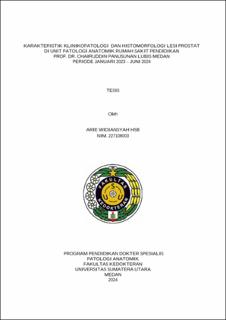| dc.description.abstract | Objective: To determine the clinicopathological and histomorphological characteristics of prostate lesions at the Unit Patologi Anatomik Rumah Sakit Pendidikan Prof. Dr. Chairuddin Panusunan Lubis Medan, from January 2023 to June 2024.
Methods: This descriptive, cross-sectional study used retrospective data from medical records through consecutive sampling. Subjects were prostate disease patients who underwent core needle biopsy and/or transurethral resection of the prostate (TUR-P), with histopathological examination using Hematoxylin & Eosin staining. Data were analyzed using descriptive statistics in Statistical Package for the Social Sciences (SPSS).
Results: Of 43 specimens, 33 patients (76.74%) had Benign Prostatic Hyperplasia (BPH) and 10 (23.26%) had Acinar Prostatic Carcinoma (APC). For BPH, the most common age group was 60-69 years (37.20%). Concordance between USG and histopathological diagnosis was 34.88% for BPH, with 6.98% disagreement. Histomorphology of BPH specimens showed papillary infolding (37.21%), cystic atrophy (39.53%), and corpora amylacea in 53.49%. Special features like squamous metaplasia were seen in 6.98%. For APC, the highest frequency was in the 60-69-year age group (16.28%). Concordance between USG and histopathology in APC was 4.65%, with 2.33% disagreement. APC specimens showed tufting (11.63%), cribriform (9.30%), micropapillary (2.33%) patterns, with blue mucin (2.33%) and crystalloid (4.65%) secretion. Signet-ring cells were found in 4.65%.
Conclusion: Benign and malignant prostate lesions were most common in the 50-59-year age group. Histomorphological characteristics of benign lesions showed papillary infolding, cystic atrophy, and corpora amylacea secretion, while malignant lesions showed tufting, cribriform, micropapillary patterns, with blue mucin and crystalloid secretion. | en_US |


